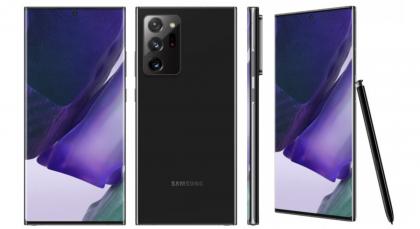Samsung Display developed a 18.2" 350 nits ink-jet printed OLED panel
Samsung Display has developed a 18.2" 2560x1440 202 PPI inkjet-printed OLED display, that features the highest current efficiency of any inkjet-printed OLED, with the brightness at 350 cd/m2 (full white).

Samsung Display says that the high brightness was achieved by tuning the top-emission device structure with high performance soluble materials. The high pixel resolution was achieved by modulating the jetting waveform for ejecting ink drops and improving the drop placement accuracy by selecting the right ink formulations in terms of viscosities and surface energies.
Samsung launches several new AMOLED devices, including the Note 20 and the Galaxy Z Fold 2
Samsung announced several new OLED devices yesterday. We'll start with the new Galaxy Note 20 which sports a 6.7-inch 1080x2400 HDR10+ Super AMOLED Plus display (which could mean this is an RGB display, not a Pentile one). The Galaxy Note 20 Ultra has a larger 6.9-inch 1440x3088 Dynamic AMOLED. The display supports a refresh rate of 120Hz at Full-HD resolution and 60Hz at QHD. According to the Elec in Korea, the Note 20 Ultra display has an LTPO backplane (which Samsung calls HOP).

Next up is the company's 2nd generation Galaxy Z Fold 2 that is an update to the original fold with a larger internal foldable display at 7.6" 1768x2208 HDR10+ 120Hz Dynamic AMOLED and also a larger 6.23" 816x2260 Super AMOLED cover display. The Fold 2 also improves the hinge design and sports an ultra-thin-glass cover (like the Galaxy Z Flip).
Samsung reports its Q2 2020 financial results, sees full-fledged mobile display recovery only in Q4 2020
Samsung reports a large increase in its profit in Q2 2020 - as the COVID 19 pandemic increases demand for memory chips, and also as a result of a one-time $950 million penalty payment from Apple following lower OLED orders.

Samsung's net profit in Q2 2020 totaled $4.67 billion (an increase of 7% from Q2 2019), while its revenues were $44.4 billion (down 6% from last year).
DSCC lowers its OLED material revenue forecast, now sees a $2.06 billion market in 2024
DSCC updated its OLED material market forecasts, seeing a lower growth ahead. DSCC says the AMOLED stack material market will grow from $928 million in 2019 to $2.06 billion in 2024 in a CAGR of 17%. Only a couple of months ago DSCC estimated that the market in 2024 will reach $2.69 billion - and even these were reduced from earlier estimates due to COVID-19.

DSCC says that the main reason behind the reduction in its forecast is lower OLED TV capacity. The company now expects a slower ramp up at the Guangzhou fab, and LG's P-10 10.5-Gen fab is now removed from the forecast period.
UBI Research: 215 million flexible OLED displays to ship in 2020
UBI Research estimates that Samsung Display's flexible OLED shipments to Chinese device makers will triple in 2020, and will reach 47 million units (up from 15.5 million in 2019). Rigid OLED shipments to China will drop from 135 million in 2019 to 110 million in 2020.
In total, SDC's flexible OLED panel production will reach 155.5 million in 2020, up 34% from 2019. This follows a couple of years of declining volumes (152 million in 2017, 129 million in 2018 and 116 million in 2019).
DSCC: Samsung received around $950 million from Apple due to lower OLED panel orders
DSCC estimates that Apple paid around $950 million to Samsung Display in the last quarter - due to lower smartphone OLED orders. Apple is committed to buy a certain amount of displays, and this payment is a fine due to lower orders.

A year ago in July 2019, Apple paid $684 million - again as compensation for lower-than-agreen-on iPhone OLED panel orders.
DSCC details the production cost and prices of flexible and foldable OLED displays
DSCC posted an interesting article detailing their estimates for the production costs and prices of choice flexible and foldable AMOLED displays, in China and in Korea.

We'll start with the chart above, which compares the prices and quotes of several flexible OLEDs produced by Samsung in Korea. DSCC says that as the profitability of Samsung's OLED business is highly dependent on fab utilization, it is currently losing money on this business as the yields in its flexible OLED lines are only 38% - and fixed costs such as personnel and depreciation cannot be decreased. Having said that, DSCC sees higher utilization in the next two quarters, which will result in profitability for SDC's OLED unit.
UBI sees fast growth in Polyimide films and ultra-thin glass for foldable smartphone displays
UBI Research estimates that foldable smartphone display makers will continue to rely on both Ultra-Thin-Glass (UTG) and Colorless Polyimide (CPI) films for at least the next five years.

UBI sees demand for CPI films will reach 4.3 million units in 2020 while demand for UTG will reach 3.5 million units. Demand for both products will grow and by 2024 it will reach 37.1 million units for CPI and 30.5 million for UTG.
DSSC updates its OLED industry outlook, sees an oversupply situation for smartphone OLEDs till 2025
DSCC updated its capacity and demand outlook for the OLED industry. DSCC says that the oversupply situation for smartphone OLEDs will continue to effect the industry for years ahead.

According to DSCC the reason for the oversupply is Samsung's near-monopoly on flexible OLED phone panels - and the fact that the company keeps prices high and prefers high profit margins even though it leads to low utilization rates. DSCC sees China's capacity (which includes LG's Gunagzhou fab) share to rise from 5% in 2017 to 30% in 2020 and finally to 49% in 2025.
DSCC sees a sharp recovery in OLED fab utilization in Q3 2020
DSCC posted an update to their OLED (and LCD) fab capacity and utilization rate estimations. DSCC thought that Samsung's rigid OLED lines will remain in high utilization (almost 90%) in 2020, but the coronavirus pandemic lowered demand for OLEDs, and Q2 saw a sharp reduction in production of both flexible and rigid OLEDs. Looking into the rest of 2020, DSCC expects demand for OLED to rise.

DSCC also sees flexible OLED capacity almost overtaking LTPS LCD capacity by the end of 2020. Both flexible and rigid OLED capacity is increasing, while LCD production is reduced (in 2019 JDI shutdown its Hakusan LCD plant which reduced LTPS LCD capacity by 7%).
Pagination
- Previous page
- Page 36
- Next page


